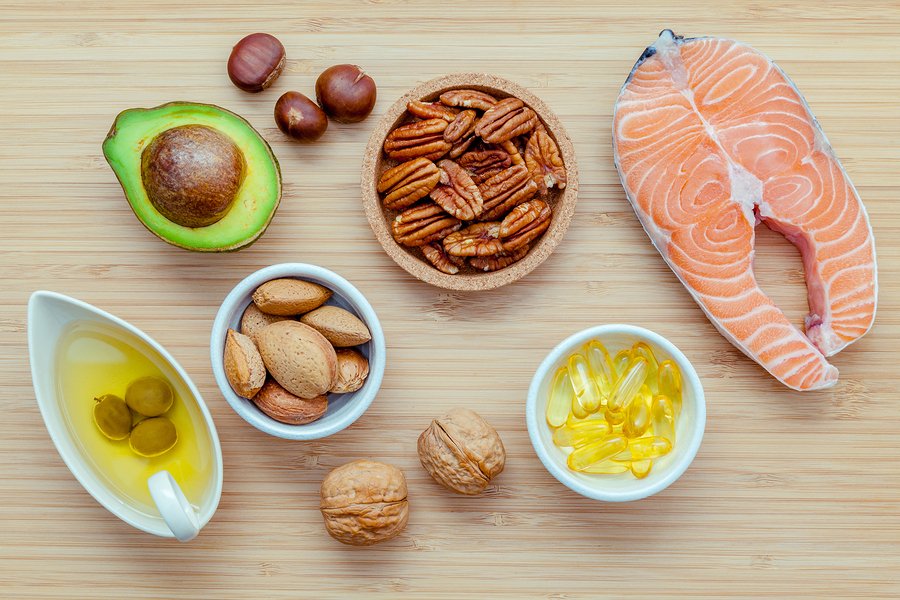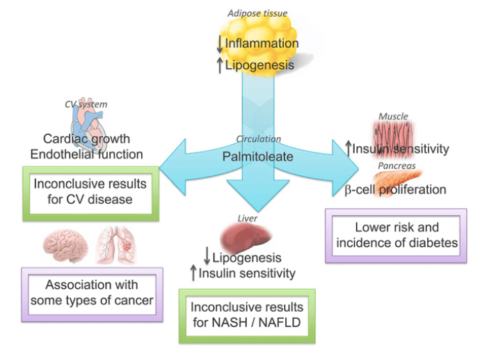
Monounsaturated fatty acids (MUFAs) are “healthy fats” that can help prevent diabetes, heart disease, and inflammation. However, they can have beneficial effects only taking into account dietary sources and other nutrients. Keep reading to learn the best food sources, benefits, and potential risks of monounsaturated fats.
What are Monounsaturated Fats?
Monounsaturated fatty acids (MUFAs) are fatty acids with one double bond in their structure, which determines some of their properties and health effects. They are found in [1]:
- Nuts
- Avocados
- Olives
- Animal fats including lard, duck, and tallow (smaller amounts)
Moderate monounsaturated fats intake may reduce the risk of heart disease, improve metabolism and immune function, and more [2].
Types of MUFAs
The most common MUFAs in daily nutrition are oleic and palmitoleic acids [3].
Oleic Acid
Oleic acid (omega-9), is a non-essential fatty acid, which means the body can create it. It may have anti-inflammatory and hearth-friendly effects [4].
For example, olive oil is 70 – 80% oleic acid. Many studies described its health benefits, such as reducing cholesterol levels, blood pressure, and inflammation [5].
Effects on Cholesterol
Oleic acid blocks cholesterol absorption in the small intestine. It activates the unfolded protein response pathway and decreases NPC1L1, which is important for cholesterol absorption [6].
Effects on Inflammation
Oleic acid can reduce inflammation due to saturated fats in human cells. It reduces ICAM-1, which is part of the inflammatory response, and phospholipase A2, an inflammatory enzyme [7].
Oleic acid has various effects on the immune system and inflammation. MUFA-rich oils might have similar anti-inflammatory effects as fish oil. Like fish oil, olive oil helps to [8]:
- Increase nitric oxide (in rats) [9].
- Decrease arachidonic acid and the production of the inflammatory mediator prostaglandin E2 [9].
- Suppress inflammatory cytokines [8].
Effects on Blood Pressure
Oleic acid reduces the stability of the cell membrane, which increases the activity of a receptor for adrenaline (α2-adrenoreceptor), thus potentially lowering blood pressure [10].
Palmitoleic Acid
Source: https://www.ncbi.nlm.nih.gov/pubmed/28096141
Palmitoleic acid (omega-7) is present in the blood and in a normal human diet [11].
In the human body, palmitoleic acid is synthesized in the liver and fat tissues. Dietary sources include macadamia oil, cod liver oil, salmon, olive oil, chocolate, eggs, dairy fats, and sea buckthorn [12].
There are two forms of palmitoleic acid: cis and trans. The cis isoform is associated with decreased fat accumulation in the liver and increased insulin sensitivity. The trans isoforms are found in dairy products and partially hydrogenated oils and may be associated with lower risks of diabetes and slightly lower body fat [12, 13].
Effects on Metabolism
Palmitoleic acid supports a healthy metabolism by:
- Activating AMPK [14].
- Activating PPAR-alpha, thus promoting fat burning to produce energy [15].
AMPK is an enzyme that activates energy-producing pathways and inhibits energy-consuming ones. It helps prevent cancer and diabetes. At the same time, it also lowers cholesterol and triglycerides [14].
PPAR-alpha is a protein that helps turn on genes (transcription factors) involved in fat burning during starvation or ketosis [15].
Other Types of MUFAs
- Undecylnic acid
- Myristoleic acid
- Petroselinic acid
- Elaidic acid
- Vaccenic acid
- Gondoleic acid
- Gondoic acid
- Cetoleic acid
- Erucic acid
- Nervonic acid
Health Benefits of Monounsaturated Fats
Possibly Effective:
1) Heart Disease
A summary of clinical reviews and meta-analyses concluded that diets high in MUFAs increase HDL (“good”) cholesterol and likely lower the incidence of heart disease. The authors suggested further research in order to shed more light and provide specific recommendations [3].
The famous “seven countries study” followed Mediterranean men and women over many decades and compared them to their counterparts in northern Europe, Japan, and the US. Those with diets rich in monounsaturated fats, including olive oil, had lower rates of heart disease [16].
A diet high in monounsaturated fats can help lower cholesterol levels. The replacement of saturated fat with MUFA can decrease LDL cholesterol and the risk of heart disease [17].
In a study of 180 patients, the Mediterranean diet (high in MUFAs) reduced body weight, markers of inflammation, and heart disease risk over 2 years [18].
Diets high in MUFAs were associated with reduced risk for heart disease, heart attack, and stroke. Oleic acid, olive oil, and Mediterranean diets all help prevent heart disease-related deaths, according to a meta-analysis of 32 studies including 841,211 subjects [19].
Blood Lipids
In studies of patients at risk of heart disease, both the high-carbohydrate diet and a high monounsaturated fat diet lowered total blood cholesterol levels. However, patients on the high monounsaturated fat diet saw lower LDL-cholesterol and triglycerides than those on the carbohydrate diet [20, 21, 22, 23].
Olive oil and other MUFAs help prevent LDL oxidation and, thus, atherosclerosis (hardening of the arteries) [17, 24].
Blood Pressure
In a study of 23 patients with elevated blood pressure, those assigned to high monounsaturated fat diets all had significantly reduced blood pressure after 6 months. Eight patients were able to stop taking blood pressure medication entirely while on the diet [25].
However, the drop in blood pressure was also linked to reduced saturated fat intake and increased nitric oxide levels stimulated by polyphenols present in olive oil, not just to the high monounsaturated fat content [25].
2) Diabetes
A summary of clinical reviews concluded that high-MUFA diets reduce blood sugar and hemoglobin A1c in type 2 diabetic patients [3].
Diets high in monounsaturated fatty acids (MUFAs) may be healthier for diabetic patients than low-fat, high-carbohydrate diets. The Mediterranean diet, which is high in MUFAs, improves glucose control and insulin sensitivity [26].
Olive oil intake is associated with a decreased risk of developing type 2 diabetes, according to a meta-analysis of 29 trials. However, some other substances in olive oil other than MUFAs may also be responsible for these effects [27].
When a group of 162 healthy people was put on a 3-month high saturated fat diet, their insulin sensitivity decreased, compared to a high MUFAs group [28].
Ten overweight diabetic patients improved their glycemic profiles (blood glucose and insulin value correlation) when placed on a high monounsaturated fat diet for 15 days [29].
Eleven pre-diabetic patients were fed 3 diets, each for 28 days, one diet high in monounsaturated fats, another high in saturated fats, and the third high in carbohydrates. These patients had less belly fat and better insulin sensitivity on the high monounsaturated fat diet [30].
However, this favorable effect on insulin sensitivity only occurs along with a low total fat intake. The high-MUFA diet had no effect on insulin secretion [31].
In mice with diet-induced diabetes and obesity, the introduction of olive oil in place of saturated fats reduced inflammation, insulin resistance, and body fat [32].
3) Rheumatoid Arthritis
A Mediterranean diet can help suppress rheumatoid arthritis symptoms. According to a study of 413 participants, high MUFA content of this diet may be the key to beneficial effects on the joints [33].
In addition, olive oil consumption was associated with a lower risk of rheumatoid arthritis in a study of 330 subjects [34].
43 RA patients given fish oil (high in omega-3) and olive oil (high in MUFA/oleic acid) had the best improvements in both pain and mobility, compared to fish oil alone or a placebo (soy oil) [35].
Insufficient Evidence:
No valid clinical evidence supports the use of MUFAs for any of the conditions in this section. Below is a summary of up-to-date animal studies, cell-based research, or low-quality clinical trials which should spark further investigation. However, you shouldn’t interpret them as supportive of any health benefit.
4) Weight Control
According to the World Health Organization, a high monounsaturated fat diet was the best predictor of low obesity rates worldwide [36].
Diets high in monounsaturated fatty acids (MUFAs), such as the Mediterranean diet, may support weight loss, along with caloric restriction and exercise [37].
A 28-day diet high in monounsaturated fats decreased belly (central) fat, which is associated with obesity, in 11 insulin-resistant patients [30].
In 32 obese women, a diet high in MUFAs led to more weight and fat loss than a high polyunsaturated fat diet or their habitual diet [37].
In 124 overweight/obese type 2 diabetics, a high-MUFA diet was as effective as a low-fat high-carbohydrate diet in terms of weight loss (4% of body weight lost), HDL levels, blood pressure, and blood sugar improvements [26].
It’s important to note that MUFA might be a useful tool in weight control only as a substitute for other macronutrients, taking into account total caloric intake. Adding them on top of daily calories may produce the opposite effects.
No complementary approach to weight loss can work in the absence of caloric restriction and increased physical activity.
5) Bone Strength
In a study of 187 women, oleic acid status was associated with increased bone strength, but certain MUFAs showed the opposite connection [38].
A higher amount of MUFA compared to polyunsaturated fat in a diet correlated with a lower risk of bone fractures in 334 elderly patients [39].
In mice, a high-MUFA diet increased bone thickness and volume in comparison to a high saturated fat and a normal fat diet [40].
6) Mood and Depression
Diets high in MUFA and olive oil correlated with lower levels of depression in a study of 12,059 Spanish students. However, total fat intake was positively associated with depression [41].
14 young adults who consumed high amounts of oleic acid (MUFA) over the course of 3 weeks reported less anger compared to those in the high palmitic acid (a saturated fatty acid) group. However, it wasn’t clear if this was due to increased MUFAs or decreased saturated fatty acids [42].
Much more research is needed in this field before drawing any conclusions.
7) Age-Related Cognitive Decline
High monounsaturated fat intake correlated with reduced risk of cognitive decline in a survey of over 5,000 elderly Italians (over age 65) [43].
Mediterranean diet has well-known beneficial effects on cognitive function. However, besides MUFAs, other components such as fish oil, cereals and red wine in moderation likely contribute [44].
The brain’s need for monounsaturated fatty acids increases with age in rats. Aging is often linked with oxidative stress in cellular membranes and DNA damage. Rats that consumed more olive oil had less age-related oxidative stress because these fatty acids are less susceptible to free radical damage [45, 46].
8) Skin Damage
In nearly 3,000 volunteers, increased intake of MUFAs from olive oil was associated with a lower risk of severe skin damage from the sun. However, there was no association with MUFA intake from animal products [47].
Animal and Cellular Research (Lacking Evidence)
No clinical evidence supports the use of MUFAs for any of the conditions listed in this section. Below is a summary of the existing animal and cell-based research, which should guide further investigational efforts. However, the studies listed below should not be interpreted as supportive of any health benefit.
Liver Protection
MUFAs can protect against liver injury due to a drug overdose.
In rats, a high-MUFA diet protected against acetaminophen (Tylenol)-induced liver injuries. The presence of monounsaturated fats in the cell membrane of liver cells reduces the cells’ susceptibility to oxidative damage [48].
In addition, diets rich in MUFAs tend to decrease liver fat content, which may protect against nonalcoholic fatty liver disease [49].
Caveats
Most of the clinical studies had shortfalls. They were either small-scale and short-term studies that relied on self-reported dietary choices or large-scale surveys. In addition, some of the observed health benefits could be caused by antioxidants and other beneficial compounds in olive oil rather than MUFAs themselves.
Side Effects and Negatives
General
Monounsaturated fats on their own do not have any toxic effects [2].
However, excessive fat intake can increase calorie consumption leading to weight gain. Foods high in MUFA can simultaneously be high in other fats [50, 51].
Diseases
A high-fat (total fat, saturated, and monounsaturated fat) diet is associated with increased gallstone disease risk [52].
In contrast to oleic acid, uncommon MUFAs can increase the risk of heart disease. 7-hexadecenoic acid and cis-vaccenic acid were associated with a higher heart attack (sudden cardiac arrest) risk in a prospective study of 2,890 elderly people [53].
Although MUFA consumption can be the cause of the increased risk, the results of this study are also associated with higher carbohydrates, protein, and alcohol intake. Therefore, it wasn’t clear if MUFAs consumption was problematic [53].
In a study of 12,059 Spanish students, total fat intake was positively associated with depression [41].
Natural Sources of Monounsaturated Fats
Source: https://www.ncbi.nlm.nih.gov/pmc/articles/PMC4879159/
1) Oils
Oils are a natural source of monounsaturated fats. Avocado, macadamia, and olive oils are predominantly monounsaturated fats. Rapeseed, peanut, almond, sesame, sunflower, and rice bran oil contain some MUFAs but are predominantly PUFA (omega-6) [54].
Even though pure oils contain the highest amounts of MUFAs, you should prioritize whole foods instead. They contain a range of other beneficial nutrients that work in synergy.
2) Nuts
Nuts are a good source of monounsaturated fats [55]:
- Macadamia nuts
- Hazelnuts
- Pecans
- Almonds
- Cashews
- Brazil nuts
- Peanuts
- Pistachios
- Pine nuts
- Walnuts
3) Other Foods
- Avocados [2]
- Olives [2]
- Red meat [54, 2]
- Mackerel [3]
- Whole fat milk products (milk, cheese) [54, 2]
SNPs and Genes that Interact with MUFAs
It’s important to note that just because certain genotypes are associated with a condition or irregular lab marker, it doesn’t necessarily mean that everyone with that genotype will actually develop the condition.
1) ADIPOQ
- rs17300539 (-11391G>A): At high MUFA intake, GG homozygotes had higher BMI and increased obesity rates compared to people with the A allele [56].
- rs266729 (-11377C>G): Men that are CC homozygous became less insulin resistant with a high-MUFA diet than with a high-saturated fat diet [57].
2) PPARγ
High intake of monounsaturated fatty acids (MUFAs) may differently affect people with the PPARγ SNP rs1801282 [58].
PPARγ is a protein that turns on other genes (transcription factor) and is activated by dietary fats. The G allele reduces PPARγ activity [59].
In an obesity intervention study where all subjects ate a Mediterranean diet, GG or GC subjects were significantly less obese than those with CC alleles [58].
In another study of 538 adults, researchers looked at their dietary intake and physical examination results. Obese people with the G allele that consumed less MUFA had higher insulin resistance. Therefore, MUFA consumption may help lower insulin resistance and diabetes risk in people with the G allele [60].
Other Gene Interactions in Animals/Cells
- In mice, oleic acid treatment increases BCRP levels, which is an important transporter for nutrients and drugs, increasing the intestinal absorption of these substances [61].
- PPARα activation induces fatty acid breakdown in the heart. In male rats, a high monounsaturated fat diet with sunflower oil moderately increased PPARα gene and protein levels [62].
- Additionally, in obese mice, the increase of MUFA content correlated with enhanced ELOVL5 expression [63].
- In cell-based studies (bovine cells), oleic acid treatment significantly reduced cellular production from the following genes: FSHR, LHCGR, STAR, CYP11A1, HSD3B1, CYP19A1, and CCND2, and increased CD36 and SLC27A1 [64].





